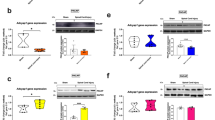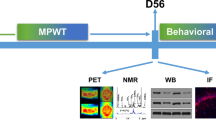Abstract
Neurosteroids are synthesized in the nervous system from cholesterol or steroidal precursors imported from peripheral sources. These compounds are important allosteric modulators of γ-aminobutyric acid A receptors (GABAARs), which play a vital role in pain modulation in the lateral thalamus, a main gate where somatosensory information enters the cerebral cortex. Using high-performance liquid chromatography/tandem mass spectrometry, we found increased levels of neurosteroids (pregnenolone, progesterone, deoxycorticosterone, allopregnanolone, and tetrahydrodeoxycorticosterone) in the chronic stage of neuropathic pain (28 days after spared nerve injury) in rats. The expression of the translocator protein TSPO, the upstream steroidogenesis rate-limiting enzyme, increased at the same time. In vivo stereotaxic microinjection of neurosteroids or the TSPO activator AC-5216 into the lateral thalamus (AP −3.0 mm, ML ±3.0 mm, DV 6.0 mm) alleviated the mechanical allodynia in neuropathic pain, while the TSPO inhibitor PK 11195 exacerbated it. The analgesic effects of AC-5216 and neurosteroids were significantly attenuated by the GABAAR antagonist bicuculline. These results suggested that elevated neurosteroids in the lateral thalamus play a protective role in the chronic stage of neuropathic pain.





Similar content being viewed by others
References
Corpechot C, Robel P, Axelson M, Sjovall J, Baulieu EE. Characterization and measurement of dehydroepiandrosterone sulfate in rat brain. Proc Natl Acad Sci U S A 1981, 78: 4704–4707.
Corpechot C, Synguelakis M, Talha S, Axelson M, Sjovall J, Vihko R, et al. Pregnenolone and its sulfate ester in the rat brain. Brain Res 1983, 270: 119–125.
Robel P, Baulieu EE. Neurosteroids: biosynthesis and function. Crit Rev Neurobiol 1995, 9: 383–394.
Compagnone NA, Mellon SH. Neurosteroids: biosynthesis and function of these novel neuromodulators. Front Neuroendocrinol 2000, 21: 1–56.
Tsutsui K, Ukena K, Usui M, Sakamoto H, Takase M. Novel brain function: biosynthesis and actions of neurosteroids in neurons. Neurosci Res 2000, 36: 261–273.
Lambert JJ, Belelli D, Hill-Venning C, Peter JA. Neurosteroids and GABAA receptor function. Trends Pharmacol Sci 1995, 16: 295–303.
Wang M. Neurosteroids and GABA-A Receptor Function. Front Endocrinol (Lausanne) 2011, 2: 44.
MacKenzie G, Maguire J. Neurosteroids and GABAergic signaling in health and disease. Biomol Concepts 2013, 4: 29–42.
Mihalek RM, Banerjee PK, Korpi ER, Quinlan JJ, Firestone LL, Mi ZP et al. Attenuated sensitivity to neuroactive steroids in gamma-aminobutyrate type A receptor delta subunit knockout mice. Proc Natl Acad Sci USA 1999, 96: 12905–12910.
Stell BM, Brickley SG, Tang CY, Farrant M, Mody I. Neuroactive steroids reduce neuronal excitability by selectively enhancing tonic inhibition mediated by delta subunit-containing GABAA receptors. Proc Natl Acad Sci USA 2003, 100: 14439–14444.
Garnier M, Boujrad N, Oke BO, Brown AS, Riond J, Ferrara P et al. Diazepam binding inhibitor is a paracrine/autocrine regulator of Leydig cell proliferation and steroidogenesis: action via peripheral-type benzodiazepine receptor and independent mechanisms. Endocrinology 1993, 132: 444–458.
Culty M, Li H, Boujrad N, Amri H, Vidic B, Bernassau JM et al. In vitro studies on the role of the peripheral-type benzodiazepine receptor in steroidogenesis. J Steroid Biochem Mol Biol 1999, 69: 123–130.
Papadopoulos V, Amri H, Boujrad N, Cascio C, Culty M, Garnier M et al. Peripheral benzodiazepine receptor in cholesterol transport and steroidogenesis. Steroids 1997, 62: 21–28.
Papadopoulos V, Lecanu L, Brown RC, Han Z, You ZX. Peripheral-type benzodiazepine receptor in neurosteroid biosynthesis, neuropathology and neurological disorders. Neuroscience 2006, 138: 749–756.
Poisbeau P, Patte-Mensah C, Keller AF, Barrot M, Breton JD, Luis-Delgado OE et al. Inflammatory pain upregulates spinal inhibition via endogenous neurosteroid production. J Neurosci 2005, 25: 11768–11776.
Patte-Mensah C, Kibaly C, Boudard D, Schaeffer V, Begle A, Saredi S et al. Neurogenic pain and steroid synthesis in the spinal cord. J Mol Neurosci 2006, 28: 17–31.
Kawano T, Soga T, Chi H, Eguchi S, Yamazaki F, Kumagai N et al. Role of the neurosteroid allopregnanolone in the hyperalgesic behavior induced by painful nerve injury in rats. J Anesth 2011, 25: 942–945.
Yen CT, Lu PL. Thalamus and pain. Acta Anaesthesiol Taiwan 2013, 51: 73–80.
Luo F, Wang JY. Neuronal nociceptive responses in thalamocortical pathways. Neurosci Bull 2009, 25: 289–295.
Schnitzler A, Ploner M. Neurophysiology and functional neuroanatomy of pain perception. J Clin Neurophysiol 2000, 17: 592–603.
Wang JY, Luo F, Chang JY, Woodward DJ, Han JS. Parallel pain processing in freely moving rats revealed by distributed neuron recording. Brain Res 2003, 992: 263–271.
Wang N, Zhang Y, Wang JY, Gao G, Luo F. Effects of pentobarbital anesthesia on nociceptive processing in the medial and lateral pain pathways in rats. Neurosci Bull 2010, 26: 188–196.
Pirker S, Schwarzer C, Wieselthaler A, Sieghart W, Sperk G. GABA(A) receptors: immunocytochemical distribution of 13 subunits in the adult rat brain. Neuroscience 2000, 101: 815–850.
Decosterd I, Woolf CJ. Spared nerve injury: an animal model of persistent peripheral neuropathic pain. Pain 2000, 87: 149–158.
Li Z, Wang J, Chen L, Zhang M, Wan Y. Basolateral amygdala lesion inhibits the development of pain chronicity in neuropathic pain rats. PLoS One 2013, 8: e70921.
Chaplan SR, Bach FW, Pogrel JW, Chung JM, Yaksh TL. Quantitative assessment of tactile allodynia in the rat paw. J Neurosci Methods 1994, 53: 55–63.
Sun Q, Tu H, Xing GG, Han JS, Wan Y. Ectopic discharges from injured nerve fibers are highly correlated with tactile allodynia only in early, but not late, stage in rats with spinal nerve ligation. Exp Neurol 2005, 191: 128–136.
Liu FY, Qu XX, Cai J, Wang FT, Xing GG, Wan Y. Electrophysiological properties of spinal wide dynamic range neurons in neuropathic pain rats following spinal nerve ligation. Neurosci Bull 2011, 27: 1–8.
Jiang H, Fang D, Kong LY, Jin ZR, Cai J, Kang XJ et al. Sensitization of neurons in the central nucleus of the amygdala via the decreased GABAergic inhibition contributes to the development of neuropathic pain-related anxiety-like behaviors in rats. Mol Brain 2014, 7: 72.
Watson C, Paxinos G. The rat brain in stereotaxic coordinates. 5th ed. Amsterdam: Elsevier Academic Press, 2005: 56–60.
Liu J, Zhang M, Wan Y, Wu HH, Hou YN, Zheng LM et al. Simultaneous determination of six neurosteroids hormones in rat brain tissues by high performance liquid chromatography-tandem mass spectrometry. Chinese J Anal Chem 2015, 43: 1118–1124.
Kita A, Kohayakawa H, Kinoshita T, Ochi Y, Nakamichi K, Kurumiya S et al. Antianxiety and antidepressant-like effects of AC-5216, a novel mitochondrial benzodiazepine receptor ligand. Br J Pharmacol 2004, 142: 1059–1072.
Papadopoulos V, Baraldi M, Guilarte TR, Knudsen TB, Lacapere JJ, Lindemann P et al. Translocator protein (18kDa): new nomenclature for the peripheral-type benzodiazepine receptor based on its structure and molecular function. Trends Pharmacol Sci 2006, 27: 402–409.
Le Fur G, Vaucher N, Perrier ML, Flamier A, Benavides J, Renault C et al. Differentiation between two ligands for peripheral benzodiazepine binding sites, [3H]RO5-4864 and [3H]PK 11195, by thermodynamic studies. Life Sci 1983, 33: 449–457.
Le Fur G, Perrier ML, Vaucher N, Imbault F, Flamier A, Benavides J et al. Peripheral benzodiazepine binding sites: effect of PK 11195, 1-(2-chlorophenyl)-N-methyl-N-(1-methylpropyl)-3-isoquinolinecarboxamide. I. In vitro studies. Life Sci 1983, 32: 1839–1847.
Le Fur G, Guilloux F, Rufat P, Benavides J, Uzan A, Renault C et al. Peripheral benzodiazepine binding sites: effect of PK 11195, 1-(2-chlorophenyl)-N-methyl-(1-methylpropyl)-3 isoquinolinecarboxamide. II. In vivo studies. Life Sci 1983, 32: 1849–1856.
Curtis DR. Bicuculline, GABA and central inhibition. Proc Aust Assoc Neurol 1973, 9: 145–153.
Curtis DR, Duggan AW, Felix D, Johnston GA. GABA, bicuculline and central inhibition. Nature 1970, 226: 1222–1224.
Patte-Mensah C, Li S, Mensah-Nyagan AG. Impact of neuropathic pain on the gene expression and activity of cytochrome P450side-chain-cleavage in sensory neural networks. Cell Mol Life Sci 2004, 61: 2274–2284.
Sherman SM. Thalamic relays and cortical functioning. Prog Brain Res 2005, 149: 107–126.
Sherman SM and Guillery RW. The role of the thalamus in the flow of information to the cortex. Philos Trans R Soc Lond B Biol Sci 2002, 357: 1695–1708.
Modol L, Cobianchi S, Navarro X. Prevention of NKCC1 phosphorylation avoids downregulation of KCC2 in central sensory pathways and reduces neuropathic pain after peripheral nerve injury. Pain 2014, 155: 1577–1590.
Hernstadt H, Wang S, Lim G, Mao J. Spinal translocator protein (TSPO) modulates pain behavior in rats with CFA-induced monoarthritis. Brain Res 2009, 1286: 42–52.
Wei XH, Wei X, Chen FY, Zhang Y, Xin WJ, Pang RP et al. The upregulation of translocator protein (18 kDa) promotes recovery from neuropathic pain in rats. J Neurosci 2013, 33: 1540–1551.
McAlonan K, Brown VJ. Tha thalamic reticular nucleus: more than a sensory nucleus? Neuroscientist 2002, 4: 302–305.
Ochoa-Sanchez R, Comai S, Lacoste B, Bambico FR, Dominguez-Lopez S, Spadoni G et al. Promotion of non-rapid eye movement sleep and activation of reticular neurons by a novel MT2 melatonin receptor ligand. J Neurosci 2011, 31: 18439–18452.
Lopez-Canul M, Palazzo E, Dominguez-Lopez S, Luongo L, Lacoste B, Comai S et al. Selective melatonin MT2 receptor ligands relieve neuropathic pain through modulation of brainstem descending antinociceptive pathways. Pain 2015, 156: 305–317.
Frye CA, Duncan JE. Progesterone metabolites, effective at the GABAA receptor complex, attenuate pain sensitivity in rats. Brain Res 1994, 643: 194–203.
Liu X, Li W, Dai L, Zhang T, Xia W, Liu H et al. Early repeated administration of progesterone improves the recovery of neuropathic pain and modulates spinal 18kDa-translocator protein (TSPO) expression. J Steroid Biochem Mol Biol 2014, 143: 130–140.
Charlet A, Lasbennes F, Darbon P, Poisbeau P. Fast non-genomic effects of progesterone-derived neurosteroids on nociceptive thresholds and pain symptoms. Pain 2008, 139: 603–609.
Schlichter R, Keller AF, De Roo M, Breton JD, Inquimbert P, Poisbeau P. Fast nongenomic effects of steroids on synaptic transmission and role of endogenous neurosteroids in spinal pain pathways. J Mol Neurosci 2006, 28: 33–51.
Acknowledgements
This work was supported by grants from the National Basic Research Development Program of China (2013CB531905, 2014CB548200, and 2015CB554503), the National Natural Science Foundation of China (81230023, 81221002, 31200835, 81571067, and 21305005), a Key Project of the Ministry of Education of China (109003), and the "111" Project of the Ministry of Education of China (B07001).
Author information
Authors and Affiliations
Corresponding authors
Rights and permissions
About this article
Cite this article
Zhang, M., Liu, J., Zhou, MM. et al. Elevated Neurosteroids in the Lateral Thalamus Relieve Neuropathic Pain in Rats with Spared Nerve Injury. Neurosci. Bull. 32, 311–322 (2016). https://doi.org/10.1007/s12264-016-0044-7
Received:
Accepted:
Published:
Issue Date:
DOI: https://doi.org/10.1007/s12264-016-0044-7




